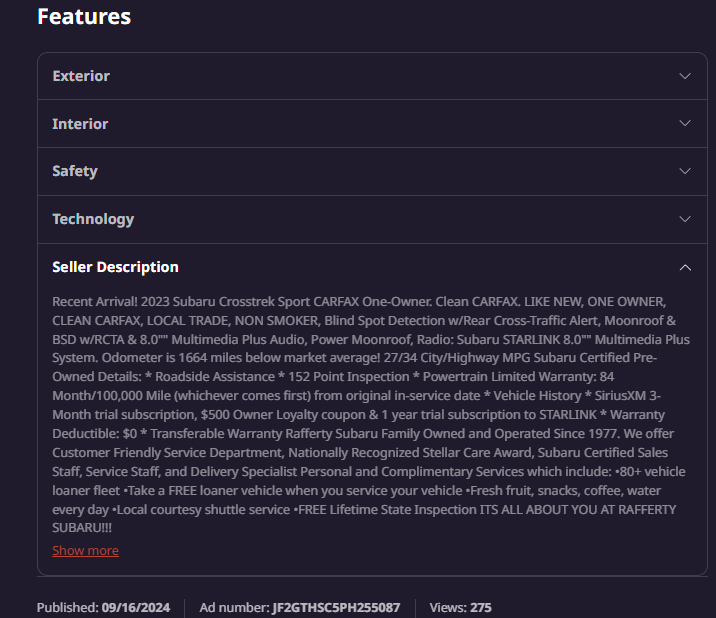Top Things to Check Before Buying a Used Car
Buying a used car can be a smart financial decision, but it's important to make sure you're getting a reliable vehicle that suits your needs. Whether you're purchasing from a private seller or a dealership, doing your due diligence can help you avoid costly mistakes down the road. Here are the top things to check before buying a used car.
1. Vehicle History Report
A vehicle history report provides valuable insights into the car’s past, including:
- Accident history
- Number of previous owners
- Service records
- Title issues, such as whether it’s been salvaged or flooded Services like Carfax or AutoCheck can help you access this information. Avoid cars with a sketchy history or significant red flags.
2. Exterior and Interior Condition
Inspect the exterior and interior for any signs of wear, tear, or damage. Some key areas to focus on include:
- Exterior: Look for dents, scratches, rust, and mismatched paint, which could signal previous repairs.
- Interior: Check for wear and tear on the seats, dashboard, and upholstery. Make sure all features (lights, windows, locks, etc.) are functioning properly.
- Tires: Uneven tire wear could indicate alignment issues or suspension problems.
3. Mileage
The mileage on a used car can give you an idea of its remaining lifespan. Typically, a car averages 12,000-15,000 miles per year. While a high-mileage car isn't always a dealbreaker, it can suggest greater wear and tear. Conversely, very low mileage for the vehicle's age may raise questions about how it was driven or maintained.
4. Test Drive
A test drive is a critical step in evaluating a used car’s condition. During the test drive, pay attention to:
- Engine Performance: Is the engine smooth and responsive? Does it make any unusual noises?
- Brakes: Test the brakes for smooth, responsive stopping. There should be no squeaking or grinding.
- Steering and Suspension: Make sure the steering is straight and the car doesn't pull to one side. Bumpy rides may signal suspension issues.
- Transmission: Check that the gears shift smoothly in both manual and automatic transmissions.
5. Mechanical Inspection
Even if the car seems to be in good shape, it’s a good idea to get a professional mechanic to inspect it before you finalize the purchase. They can check for hidden issues, such as:
- Leaks (oil, coolant, transmission fluid)
- Exhaust system condition
- Brake wear
- Engine health Many dealerships may offer an inspection or allow you to bring a mechanic, but make sure this step isn't overlooked if buying privately.
6. Under the Hood
Take a quick look under the hood to assess the overall condition of the engine. Some things to look for include:
- Fluids: Check the oil, transmission fluid, brake fluid, and coolant. Dirty or low fluids could indicate poor maintenance.
- Belts and Hoses: Ensure there are no cracks or signs of excessive wear.
- Battery: Check for corrosion around the terminals and test the battery life if possible.
7. Frame Damage
Inspect the frame and undercarriage for signs of damage or rust, which could indicate previous accidents. If the frame isn’t straight, it may affect the car's handling and safety. Any major damage to the undercarriage could also cause costly future repairs.
8. Title and Ownership
Make sure the car has a clean title. A "clean" title means the vehicle has not been declared a total loss by an insurance company. Ensure there are no liens on the car, which could complicate the ownership transfer. Always double-check the VIN (Vehicle Identification Number) to ensure it matches the title and registration documents.
9. Safety Features
Modern cars come with a variety of safety features, but if you're buying an older model, it's crucial to verify:
- Airbags: Check for deployed or faulty airbags.
- Brakes: Confirm whether the car is equipped with ABS (anti-lock braking system).
- Tires and Lights: Ensure all lights work properly, including headlights, brake lights, and turn signals.
10. Price Research
Finally, be sure to do your homework on the car's market value. Use tools like Kelley Blue Book or Edmunds to get an idea of what the car should cost based on its make, model, year, condition, and mileage. This ensures you’re paying a fair price and can also give you leverage during negotiations.
Buying Through JitCar.com
Make sure you always check the list of features and any notes listed.

Conclusion
Buying a used car can be a cost-effective way to get the vehicle you want, but it requires a careful evaluation of the car's condition and history. By following these steps and checking the key areas, you’ll increase your chances of driving away with a reliable vehicle that suits your needs. If you’re looking for a wide selection of used cars, visit Jitcar to find your perfect match.


